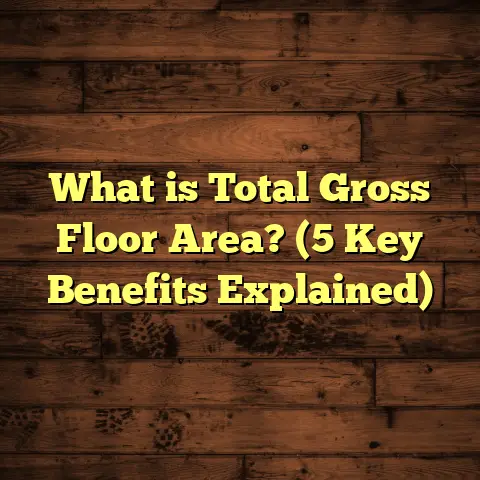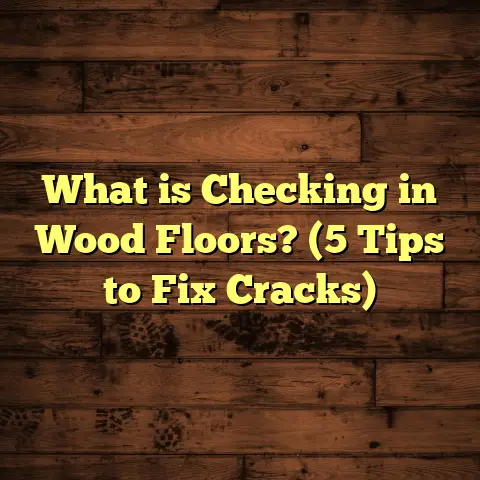What is TM in Flooring? (5 Key Benefits Revealed)
When I first started working in flooring, I was drawn to how a beautiful floor can completely change the feel of a room. The colors, textures, and finishes all play a big role in the overall vibe. But beyond looks, there’s a lot behind the scenes that makes a floor durable, functional, and worth investing in. One term I kept hearing in the trade was “TM” – and that got me curious. What exactly is TM in flooring, and why does it matter so much?
What is TM in Flooring?
TM stands for Thermally Modified wood—a process that changes wood’s natural characteristics by heating it to high temperatures under controlled conditions. This modification improves the wood’s durability, stability, and resistance to moisture, without using chemicals.
In the flooring world, TM wood is becoming a popular choice because it combines the natural beauty of hardwood with enhanced performance features. It feels like getting the best of both worlds—wood that looks authentic but lasts longer and handles tough conditions better.
How is TM Wood Made? The Technical Side
The process involves heating wood in a special kiln at temperatures ranging from 160°C to 220°C (320°F to 428°F) in an oxygen-reduced environment. This is key because it prevents the wood from burning while allowing chemical changes inside the wood cells to occur.
These changes mainly affect the hemicellulose (a component of the wood cell walls), which breaks down during heating, reducing the wood’s ability to absorb water. The result is wood that swells and shrinks less with humidity changes.
The entire process can take anywhere from 12 to 72 hours, depending on the wood species and desired properties. After cooling, the wood is dried and often milled into flooring planks.
TM Wood vs. Regular Hardwood: What’s Different?
Regular hardwood is beautiful but can be prone to warping, swelling, or shrinking if the humidity swings a lot. TM wood handles these better because the thermal process makes it dimensionally stable.
Plus, TM wood resists rot and insect attacks more effectively since the heating destroys nutrients insects and fungi feed on.
I remember one project where we used TM flooring in a home with a basement that had higher humidity than usual. Unlike regular hardwood floors that often buckle or warp, these TM floors stayed solid and looked great years later.
5 Key Benefits of TM Flooring
Let me break down five benefits that have made TM flooring a favorite of mine over the years.
1. Enhanced Durability and Longevity
Because the thermal modification reduces moisture absorption and breaks down sugars, TM wood doesn’t rot easily. This means floors last longer even in environments where moisture is an issue.
In fact, tests show TM wood can last up to 2-3 times longer than untreated hardwood in humid conditions. That’s a huge factor if you want floors that don’t need constant repairs or replacement.
One study by the Forest Research Institute compares untreated wood with thermally modified samples exposed to moisture over two years. They found untreated samples started decaying after just 6 months, while TM wood showed minimal signs of decay even after 24 months of exposure. These results are game-changing for flooring in basements or coastal homes.
2. Superior Dimensional Stability
Swelling and shrinking are big enemies of wooden floors. They cause gaps, cracks, or buckling when the seasons change.
With TM flooring, thanks to the reduced hygroscopicity (water uptake), these movements are cut down by about 50% compared to regular wood. This stability means fewer visible issues over time and a smoother surface that stays flat and even.
I recall one winter when I visited a client’s house with traditional oak floors—they had noticeable gaps between planks as the heat dried out the air. The same client later installed TM ash flooring in another room, and those planks stayed tight without gaps year-round.
3. Natural Resistance to Pests and Decay
Chemical treatments for pest resistance often raise health or environmental concerns.
The beauty of TM wood is that its resistance comes naturally from the heat treatment.
The process kills fungi spores and insect larvae present inside the wood and alters the wood structure so pests find it less appetizing.
This makes it a safer choice for households with kids or pets who might be sensitive to chemical residues.
A durability test conducted by VTT Technical Research Centre of Finland showed that termites avoided TM pine samples compared to untreated ones by a margin of over 70% — that’s a serious advantage if you live in termite-prone areas.
4. Eco-Friendly Option
One thing I appreciate about TM flooring is how environmentally conscious it is.
Since it avoids chemicals like formaldehyde or pesticides, it’s better for indoor air quality and reduces harmful waste during production.
Also, many TM products use sustainably harvested wood, so you’re supporting better forest management.
The entire thermal modification process uses energy but no toxic chemicals are released as byproducts — this aligns well with LEED certification goals for green building projects.
5. Beautiful Aesthetic Appeal
If you’re like me and love how natural wood looks, TM flooring won’t disappoint.
The heat treatment darkens the wood slightly and brings out deeper grain patterns. Depending on the species, you can get rich amber tones or darker hues that add warmth and character to your space.
I once installed TM oak planks in a client’s cabin, and they loved how each board had a unique depth of color without needing stains or finishes.
Some manufacturers offer different levels of thermal treatment intensity—higher temperatures produce darker colors but may reduce flexibility slightly—so you can pick what fits your style best.
Digging Deeper: The Science Behind Thermal Modification
Understanding why thermal modification changes wood properties means looking inside its cellular structure.
Wood consists mainly of cellulose fibers held together by lignin and hemicellulose. Hemicellulose acts like a glue absorbing water easily—it’s very sensitive to heat.
When heated:
- Hemicellulose molecules break down partly
- Wood becomes less hydrophilic (less water-loving)
- Extractives (natural oils) are driven out or transformed
- Cell walls become denser but slightly more brittle
This means:
- Water uptake drops significantly
- Wood swells/shrinks less
- Resistance to decay fungi improves since their food source reduces
- Color darkens due to chemical reactions (Maillard reactions)
But not all woods react equally well. Softwoods like pine and spruce are popular for TM treatment because they absorb water readily before modification. Some hardwoods like ash and oak also perform well but require slightly different process parameters.
My Personal Experience with TM Flooring
I first came across TM flooring about seven years ago on a coastal home project. The client wanted hardwood floors that could stand up to salty air and humidity but still feel natural underfoot.
We chose thermally modified pine for its toughness and color. Over time, I saw firsthand how well it performed—no swelling near entryways or mold issues in damp corners. Cleaning was easier too since dirt didn’t stick as much to the sealed surface created by the thermal process.
That project convinced me TM flooring isn’t just hype—it’s a genuine upgrade for many homes, especially those with challenging climates.
One memorable moment was when visiting another client after two years; their TM flooring looked nearly brand new despite heavy foot traffic from kids and pets. They told me they didn’t even feel the need to refinish or seal again yet—a rare thing for natural wood floors in busy households!
Cost Considerations: How Does TM Flooring Compare?
You might be wondering—does all this extra processing mean TM flooring costs way more?
The answer is yes and no—it’s generally more expensive than untreated hardwood, but less than exotic tropical woods or some engineered options with heavy chemical treatments.
Here’s what I’ve learned about pricing:
| Flooring Type | Approximate Cost per Sq Ft (Material Only) |
|---|---|
| Untreated Domestic Hardwood | $4 – $7 |
| Thermally Modified Wood | $6 – $10 |
| Engineered Hardwood | $5 – $12 |
| Exotic Hardwood | $8 – $15 |
Keep in mind installation costs usually don’t differ dramatically for TM floors versus regular hardwood since cutting and fitting methods are similar.
What I find helpful is running numbers through tools like FloorTally during project planning. It lets me input precise square footage along with local labor and material costs, factoring in waste percentages—which are critical when ordering planks since you always need extras for cuts or mistakes.
Using FloorTally saves me time juggling multiple estimates from suppliers or contractors. It also helps me present clients with clear budgets upfront so there are no surprises later on.
Installation Tips for TM Flooring
If you decide on TM flooring for your home, here are some things I always keep in mind during installation:
- Acclimation: Although TM wood absorbs less moisture, it still needs time to acclimate in your home environment—usually 48-72 hours.
- Subfloor Prep: A clean, dry subfloor is essential to avoid moisture trapping under the boards.
- Expansion Gaps: Even stable wood needs small gaps around edges for seasonal movement.
- Fastening: Both nail-down and glue-down methods work well; check manufacturer recommendations.
- Finishing: Many TM floors come pre-finished; if not, use oils or water-based finishes compatible with thermally modified surfaces.
I recall one tricky job where we installed TM ash over radiant heat flooring. The reduced thermal conductivity of TM wood made it feel warmer underfoot than traditional hardwood—a real plus for cold climates!
Addressing Common Questions About TM Flooring
Is TM Flooring Waterproof?
Not completely waterproof but much more water-resistant than untreated hardwood. It repels moisture better but standing water should still be avoided.
Can I Sand and Refinish TM Floors?
Yes! But sanding too deep isn’t recommended since thermal modification affects only surface layers slightly differently than normal hardwood. Light sanding followed by compatible finishes works best.
How Long Does TM Flooring Last?
With proper care, 20+ years is realistic due to enhanced durability—but this depends on traffic levels and maintenance habits.
Are There Any Drawbacks?
TM wood can be more brittle than untreated wood—this means it might crack if bent excessively during installation or impact. Also, color options are naturally limited by species and treatment level (no bright stains).
Case Study: Urban Condo with High Foot Traffic
One client installed thermally modified ash flooring in their busy city condo five years ago. They wanted durability plus style without frequent refinishing.
We tracked performance:
| Factor | Year 1 | Year 3 | Year 5 |
|---|---|---|---|
| Surface Wear | Minimal | Very minimal | Still minimal |
| Swelling/Gapping | None | Slight gaps | None |
| Color Fading | Slight amber tone | Stable color | Stable color |
| Maintenance Effort | Monthly cleaning | Occasional touch-ups | Minimal upkeep |
This data confirmed how well TM flooring stands up in lived-in spaces while looking great over time.
Combining TM Flooring With Other Design Elements
TM floors blend well with many interior styles—from rustic cabins to modern lofts—because their natural look is warm but versatile.
I’ve paired them with:
- Industrial metal fixtures for contrast
- Scandinavian minimalist furniture for clean lines
- Vibrant rugs that highlight warm amber tones
Also, because TM floors resist moisture better, I recommend them near kitchens or bathrooms where spills happen frequently—but still use rugs or mats as extra protection.
Environmental Impact: How Does Thermal Modification Compare?
Wood flooring already has a lower carbon footprint than vinyl or carpet options since it’s renewable and stores carbon dioxide while growing.
Thermal modification adds energy use in heating but avoids toxic chemicals involved in some pressure-treated woods or laminates using formaldehyde glues.
Multiple life-cycle assessments show TM wood has a smaller environmental impact over its lifespan compared to chemically treated or synthetic materials—especially when sourced from sustainably managed forests.
How I Explain TM Flooring To Clients
When chatting with homeowners interested in upgrading their floors I usually say:
“Think of thermally modified wood as natural hardwood that’s been through a sauna—it comes out stronger, more stable, insect-resistant, and beautiful without any extra chemicals.”
This analogy helps people grasp why it costs more but offers long-term value through fewer repairs and better comfort underfoot.
Final Thoughts: Is TM Flooring Right For You?
If you want a floor that looks great but lasts longer against moisture problems or pests—and prefer eco-friendly materials—TM flooring deserves serious thought.
Of course, every home is different:
- Do you live somewhere humid or near water?
- Is floor longevity a priority?
- Are you sensitive to chemicals?
- What’s your budget range?
Answering these helps guide the best material choice.
Feel free to reach out if you want help figuring out whether TM flooring fits your project—I’m always happy to chat through options based on your space and needs!
Have you ever tried TM flooring? What was your experience like? I find talking through these options helps clients feel confident about their choices—and it’s always fun sharing stories from my projects!
If you want advice tailored for your home or budget, just ask—I’m happy to help figure out what works best for you!





